Sudden drops in Greenland temperature and tropical rainfall patterns during the last Glaciation have been connected recently to rapid changes in the salinity of the North Atlantic Ocean. Climate change seems to affect and to be affected by ocean circulation and chemistry.
Scientists rebuilt a 45,000- to 60,000-year-old record of ocean temperature and salinity studying chemical clues from fossil foraminiferea (marine protozoa) shells sampled from sea sediment cores. These results were compared to those that were recorded in Greenland ice cores abrupt climate change. The sudden climate change in Greenland matched with rapid changes in surface-water salinity in the north Atlantic.
The Northern Atlantic was saltier during cold periods, and fresher during warm intervals. "The freshening likely reflects shifts in rainfall patterns, mostly in the tropics," Howard Spero of the University of California at Davis said. "Suddenly, we're looking at a record that links moisture balance in the tropics to climate change. And the most striking thing is that a measurable transition is happening over decades."
The Glaciation covered much of North America and Europe under an ice sheet. But the ice sheet in Greenland recorded repeated patterns of sudden warming, called Dansgaard-Oeschger Cycles, when temperatures in Greenland rose by 5 to 10 degrees Celsius over a few decades.
In the tropical area, warm, moist air forms a zone of heavy tropical rainfall, called the Intertropical Convergence Zone, which dilutes the salty ocean with fresh water. Currently, the tropical rainfall zone gets to the northern Caribbean, but during the Ice Age it was restricted much further south, towards Brazil. "That kept fresh water out of the northern Atlantic, so it became more salty", Spero said.
The currents in the North Atlantic moves warm, salty water north, maintaining Europe's climate between some limits. "The deep ocean circulation is very sensitive to the saltiness of north Atlantic surface waters", Spero said.
The current warming climate, higher rainfall and fresher conditions can disrupt the movement of the warmer waters in Northern Atlantic circulation, which would mean a cooler climate in Western Europe, as it happened during the Glaciation. The analysis showed that the cooling climate in Greenland was linked to a rapidly increased salinity in the North Atlantic subtropical circulation. "The build-up of salt during these cold intervals when the conveyor circulation was reduced would have primed the system to quickly restart on transitions into warm intervals," Schmidt said. "However, the actual trigger that caused Atlantic circulation to restart during the Ice Age is still unknown," he said.
The melting in the past of the ice sheets would have brought fresh water to the Atlantic, but this would have been partly buffered by the elevated saltiness of the Atlantic.

 14 DAY TRIAL //
14 DAY TRIAL //